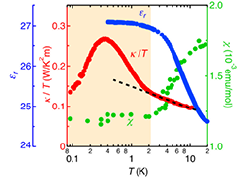Quantum-Disordered State of Magnetic and Electric Dipoles in a Hydrogen-Bonded Organic Mott System
Yamashita and Mori Groups
Strongly enhanced quantum fluctuations often lead to a rich variety of quantum-disordered states. A representative case is liquid helium, where zero-point vibrations of the helium atoms prevent its solidification at low temperatures. A similar behavior is found for the internal degrees of freedom in electrons. Among the most prominent is a quantum spin liquid (QSL), in which highly correlated localized spins fluctuate even at absolute zero. Recently, a coupling of spins with other degrees of freedom has been proposed as an innovative approach to generate even more fascinating QSLs, but such an idea is limited to the internal degrees of freedom in electrons.

Fig. 1. A combination of the temperature dependences of the dielectric constant εr (blue, left axis), the thermal conductivity divided by temperature κ/T (red, left axis) and the magnetic susceptibility χ (green, right axis) for H-Cat. The values of χ are taken from ref. 2. The dashed line is an eye guide. The shaded region represents the QPE and QSL phases.
The hydrogen-bonded organic Mott insulator κ-H3(Cat-EDT-TTF)2 (hereafter abbreviated as H-Cat) [1-3] synthesized by Mori group in ISSP shows considerable promise as a new type of QSLs, where H2Cat-EDT-TTF is catechol-fused ethylenedithiotetrathiafulvalene. This compound has been reported to exhibit a two-dimensional (2D) QSL state; however, in contrast to other 2D organic QSL materials, the 2D π-electron layers of H-Cat are connected by hydrogen bonds, not separated by non-magnetic insulating layers. From the previous theoretical works [4,5], zero-point motion associated with this hydrogen atoms (termed “proton fluctuations”) is believed to be strongly enhanced, leading to the realization of a QSL state through strong coupling between the hydrogen bonds and the π-electrons. However, it has not been established whether such strong quantum proton fluctuations are indeed present in H-Cat, and if so, how the quantum fluctuations affect the QSL state.
Here we demonstrate, by using a combination of dielectric permittivity and thermal conductivity measurements, that the quantum proton fluctuations in H-Cat provide a quantum-disordered state of magnetic and electric dipoles through the coupling between π-electrons and hydrogen atoms [6]. First of all, we focus on proton dynamics in H-Cat. As shown in Fig. 1, the dielectric constant εr (T) of H-Cat steeply increases with decreasing temperature and then saturates below 2 K. The temperature dependence of εr (T) for H-Cat is a typical dielectric behavior in quantum paraelectric (QPE) materials such as SrTiO3, in which long-range electric order is suppressed by strong quantum fluctuations. From the fitting result by Barrett formula describing the QPE state, we have found the presence of an antiferroelectric (AFE) interaction in H-Cat, which is consistent with the AFE configuration resulting from a hydrogen-bond order in the deuterated analog of H-Cat, κ-D3(Cat-EDT-TTF)2 (denoted as D-Cat) [3]. Thus, the observed quantum paraelectricity in H-Cat clearly shows the presence of strong quantum fluctuations that suppress the hydrogen-bond order as observed in D-Cat, that is, the persistence of enhanced proton fluctuations down to low temperatures.
We next examine how the proton dynamics in the QPE state affects the nature of the QSL state in H-Cat. For this purpose, in Figure 1, we plot the temperature dependence of the thermal conductivity divided by temperature κ/T (this work) and the magnetic susceptibility χ [2] for H-Cat, together with the above-mentioned εr. Below 2 K, the thermal conductivity increases upon entering the QPE state, where εr saturates. The characteristic temperature coincides with the temperature at which the susceptibility becomes constant; this occurs when the spin correlation develops in the QSL state. The coincidence of the QPE and QSL states is surprising and strongly suggests that the development of the quantum proton fluctuations triggers the emergence of the QSL. We now theoretically analyze the effects of proton dynamics on the QSL state. According to our model that captures the essence of H-Cat system [7], low-energy proton fluctuations (~1 meV) modulate the amplitude of the electron transfers and the energy levels of the molecular orbitals. These effects may induce a dynamical modulation of exchange coupling energy J as well as a reduction of the on-site Coulomb repulsion U due to the bi-polaron effect. As a result, the magnetic long-range order would be suppressed by proton dynamics of H-Cat, inducing a QSL.
In conclusion, we have successfully discovered a quantum-disordered state of magnetic and electric dipoles in a hydrogen-bonded organic Mott system, H-Cat. Importantly, this system has 2D π-electron layers connected by hydrogen bonds, in contrast to the other organic QSL candidates with those separated by anion layers. This structural feature of H-Cat enables us to discover a new mechanism to stabilize the QSL state, where the electron and proton degrees of freedom are strongly coupled. Utilizing such a strong coupling between multiple degrees of freedom will advance our explorations of quantum phenomena such as orbital–spin liquids and electric–dipole liquids.
References
- [1] T. Isono et al., Nat. Commun. 4, 1344 (2013).
- [2] T. Isono et al., Phys. Rev. Lett. 112, 177201 (2014).
- [3] A. Ueda et al., J. Am. Chem. Soc. 136, 12184 (2014).
- [4] T. Tsumuraya, H. Seo, R. Kato and T. Miyazaki, Phys. Rev. B 92, 035102 (2015).
- [5] K. Yamamoto et al., Phys. Chem. Chem. Phys. 18, 29673(2016).
- [6] M. Shimozawa et al., Nat. Commun. 8, 1821 (2017).
- [7] M. Naka and S. Ishihara, arXiv:1801.04661.
